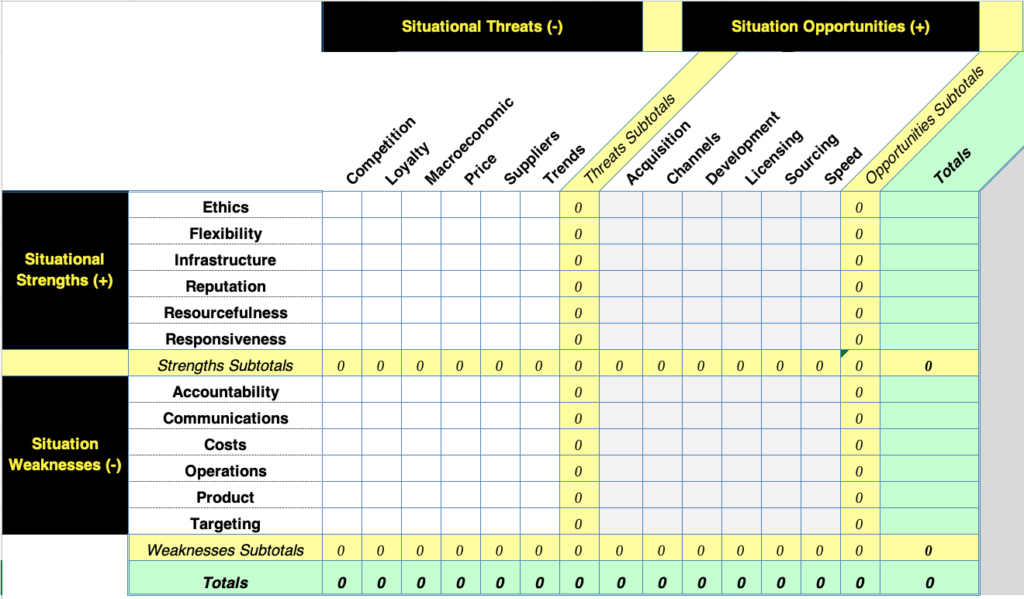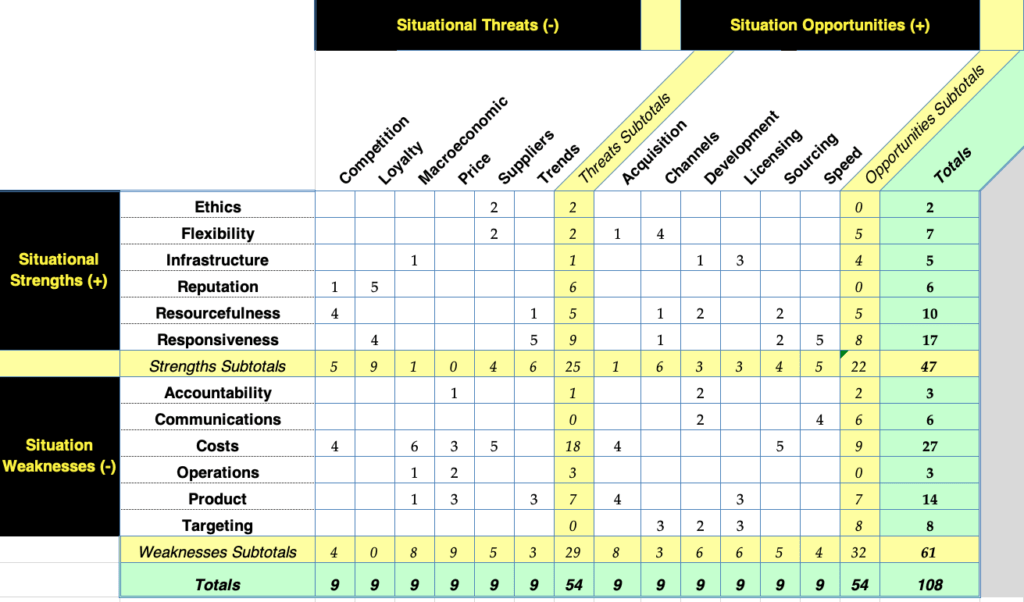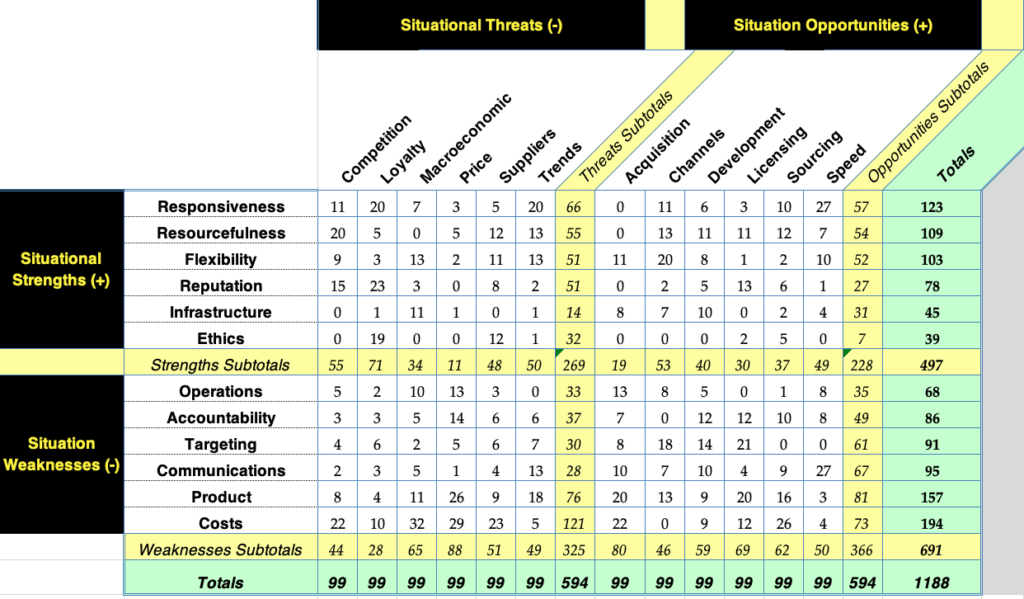Quantitative SWOT analysis contrasts the internal, controllable aspects of the organization (i.e., Strengths and Weaknesses) with external, uncontrollable situational factors (i.e., Opportunities and Threats) to create consensus around potential actions an organization might take to reach its goals and objectives.
Qualitative situational analysis[1] provides a poor method for building consensus. In what Dr. Tufte refers to as ‘flatland’, answers pop out at people, but not consensual answers. Therefore, consider using quantitative SWOT analysis, developed by Terrence Metz while attending the Kellogg School of Management at Northwestern University. Traditionally, SWOT provides a narrative description of the current situation. We encourage a quantitative approach whenever you are faced with prioritizing a complex situation involving dozens, or even hundreds of options.
TO-WS (SWOT) QUANTITATIVE ANALYSIS (Current Situation or Situation Analysis)
This activity describes the current Situation by developing a shared understanding to support WHAT Actions a group should embrace so that they reach their Key Measures such as objectives (SMART), goals (fuzzy), and considerations (binary).
A quantitative view of the Current Situation displays the foundation for justifying Actions. Consequently, Actions that currently work well are potentially reinforced and renewed alongside new Actions that get approved and developed.
The term used to describe Actions will change depending on your level in the holarchy. For example, an organization will refer to Actions as strategies, a business unit may use the term initiatives, a department or program office may call their Actions new products or new projects, and a product or project team may call their Actions, activities, or tasks. For each group, the term used represents WHAT the group is going to do to reach its Key Measures that were established to ensure that the group achieves its Vision.
The Current Situation provides consensual descriptions of:
- Current environment (TO-WS)
- Threats (externally uncontrollable, frequent trends)
- Opportunities (externally uncontrollable, frequent trends)
- Weaknesses (internally controlled, as viewed by competitors or competitive forces)
- Strengths (internally controlled, as viewed by competitors or competitive forces)
- Assumptions made in developing analysis
- Model representing how stakeholders view the business or organization
WHAT Actions the group foresees, given their Current Situation, to help reach or exceed their Measures in support of achieving their Vision
General Questions, Which . . .
- threats are most worrisome and justify defense?
- opportunities provide a real chance of success?
- weaknesses need the most correction?
- core competencies or strengths should be leveraged?
Procedure
- Have people prepared to share their TO-WS factors in advance but keep them private. Let them reference their notes as we proceed.
- Develop consensual lists and complete definitions (use Definition Tool) for each Threat, Opportunity, Weakness, and Strength. If necessary, reduce each list to the top four to six factors (see Categorizing logic and then use PowerBalls for prioritizing, along with Bookends to prevent wasting time).
- As you build four different lists, describe each entry clearly and carefully. Threats and Opportunities are externally uncontrolled and frequently represent trends. Weaknesses and Strengths are internally controlled as viewed by competitors and outsiders.
- Build and enforce strong definitions and potential measurements behind each TO-WS. For example, the strength of ‘Brand’ could be measured as market share among target customers or the threat of ‘Transportation Costs’ could be indexed to the cost of a barrel of oil or the price for a liter of diesel.
NOTE: Reverse the common SWOT sequence to TO-WS because it’s easier and more effective to deal initially with external factors, especially Threats. Technically, there are only two lists, both with a plus and minus end of their continuum. If the factor is external and you do not control it, by definition it must be a Threat or an Opportunity (TO). Therefore, if the factor is internal and you control it, by definition it must be a Weakness or a Strength (WS).
REMEMBER: NEVER allow a group to define an internally controllable Weakness as an Opportunity for improvement. If it is controllable, by definition it is a Weaknesses and NOT an Opportunity.
We call it TO-WS because most experts agree this is the best sequence to consider:
-
- External Threats: It’s easy to imagine what could go wrong.
- External Opportunities: Since Threats come more easily, remind participants to refer to their list of prepared factors.
- Internal Weaknesses: Participants are usually more sensitive about things going wrong than to what is positive.
- Internal Strengths: Begin by referring to their notes.
NEXT
- Create a definition package so that each of the characteristics scored is based upon an agreed ‘operational definition.’
- Convert your four lists into a matrix (usually a spreadsheet) with Threats (-) and Opportunities (+) on the horizontal axis and Strengths (+) and Weaknesses (-) on the vertical axis (because it is easier to visually focus on columns rather than rows).
- Remind participants that they are on the inside looking out and have them score, using instructions that follow later.
- Aggregate the individual scores into a collective score. If you are using the spreadsheet, it will automatically calculate a group total.
- Review with the group to identify the most impactful Actions—strategies, initiatives, products, projects, or activities.
CRITICAL NOTE:
Carefully enforce the operational level in your holarchy and meeting scope because the Strengths and Weaknesses MUST BE within the control of THIS group, NOT simply the company or organization. For example, a department may not control its budget so financial resources may be viewed as a Threat to the group because they do not control the budget or financial assets.
Sample Questions to Generate Threats:
- What is your competition doing much better than you?
- What regulatory issues could stop or hinder progress?
- Which trends are a real threat to your organization/ project?
Some Questions to Generate Opportunities:
- What are you not doing yet but could easily see yourself doing with the right momentum?
- Name a political policy that might help.
- Which trends provide a new opportunity for you?
Sample Questions to Generate Weaknesses:
- What could you improve?
- Detail something not working so well.
- What do others outside do poorly and so do you?
- What should you stop doing?
Some Questions to Generate Strengths:
- How do you currently achieve success?
- What do you do better than others?
- What do others outside view as your strengths?
PARTICIPANT SCORING INSTRUCTIONS
- Working within each column (i.e., external factor), one at a time ask: “What am I suggesting we do (to take advantage of this specific opportunity) or (to defend us against this specific threat)?”
- As you decide on WHAT to do, write down your most important ideas on a separate piece of paper to bring with you to the next meeting.
- You have nine points to be used in each column. Within each column, distribute the nine (9) points according to the impact or perceived value of each proposed Action (i.e., WHAT we should do to seize an opportunity or defend ourselves against a threat).
The total for each column should equal nine (9).
- Avoid assigning one point to multiple items by awarding the most significant items three, four, or more points.
- Strive to assign points to three cells at most in each column. Assigning nine points to only one cell is okay. Another tactic might be to assign five (5) points to the most important, three (3) points to the next important, and one (1) point to the third most important cell, with the balance of the cells kept blank.
- Use your business understanding—a blank cell does not mean it is unimportant. Rather, it means it is less important than others that offer more impact or leverage. If you are compelled to assign similar values to everything, the results will be watered down and provide less value for developing Actions than if you focus on the most compelling Actions.
NOTE: Participants should think about each cell in a column carefully when asking “WHAT can we do to seize this opportunity?” or “WHAT do we need to do to defend against this threat?” They might write their thoughts on a separate sheet of paper and when they have completely analyzed a column, go to the cells that represent the most important ideas and put the most points in those cells.
Scoring Tabulation
- Collect the scoring. Using a spreadsheet, compute the final scores for each cell intersection, each column, each row, and each quadrant.
- Review the scores with the group and highlight the rows and quadrants with the most significant (i.e., highest) scores.
- Immediately move to the next step in the agenda to convert the results into narrative Actions. Anticipate the ‘law of large numbers’ as people speaking early will defend themselves with the ‘large numbers’ from the spreadsheet.
Riffs and Variations
Using Bookend rhetoric, force rank each Strength or Weakness specific to each external factor. For example, if there are twelve combined Strengths and Weaknesses, we would support the following analysis for each column:
-
- Instruct each participant to ask: “Of these twelve controllable factors, which has the greatest impact on (taking advantage of this opportunity) or (defending us against this threat)?” More is better so assign the answer a twelve (12).
- Now instruct each participant to ask: “Of the remaining eleven factors, which has the least impact on . . . ?” Assign a one (1).
- Continue using Bookends, which is next most, next least, etc., until all have been assigned a rank.
- Aggregate scores and continue to convert them into Actions described in the next Agenda Step.
You might conduct a Quantitative TO-WS for the current date and situation, and then conduct another Quantitative TO-WS for some agreed-upon date in the future. Encourage participants to unveil the strategy by determining what Actions will get us from the current date to the future date.
To support change management, you could also conduct Quantitative TO-WS at varying levels within the organization. Contrasting the Current Situation at the C-Suite, Director, and supervisory levels provides interesting and compelling evidence as to WHAT “Actions” need to occur that will get us from where we are to where we would like to be in the future.
______
Don’t ruin your career by hosting bad meetings. Sign up for a workshop or send this to someone who should. MGRUSH workshops focus on meeting design and practice. Each person practices tools, methods, and activities daily during the week. Therefore, while some call this immersion, we call it the road to building high-value facilitation skills.
Our workshops also provide a superb way to earn up to 40 SEUs from the Scrum Alliance, 40 CDUs from IIBA, 40 Continuous Learning Points (CLPs) based on Federal Acquisition Certification Continuous Professional Learning Requirements using Training and Education activities, 40 Professional Development Units (PDUs) from SAVE International, as well as 4.0 CEUs for other professions. (See workshop and Reference Manual descriptions for details.)
Want a free 10-minute break timer? Sign up for our once-monthly newsletter HERE and receive a free timer along with four other of our favorite facilitation tools.

Terrence Metz, MBA, CSM, CSPF, PSP01, HTTO1, is the Managing Director of MG RUSH Facilitation Leadership, Training, and Meeting Design, an acknowledged leader in structured facilitation training, and author of “Meetings That Get Results – A Facilitator’s Guide to Building Better Meetings.” His FAST Facilitation Best Practices blog features nearly 300 articles on facilitation skills and tools aimed at helping others lead meetings that produce clear and actionable results. His clients include Agilists, Scrum teams, program and project managers, senior officers, and the business analyst community among numerous private and public companies and global corporations. As an undergraduate of Northwestern University (Evanston, IL) and an MBA graduate from NWU’s Kellogg School of Management, his professional experience has focused on process improvement and product development. He continually aspires to make it easier for others to succeed.




